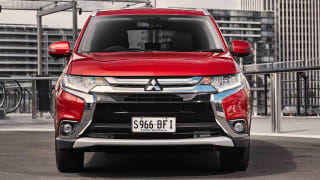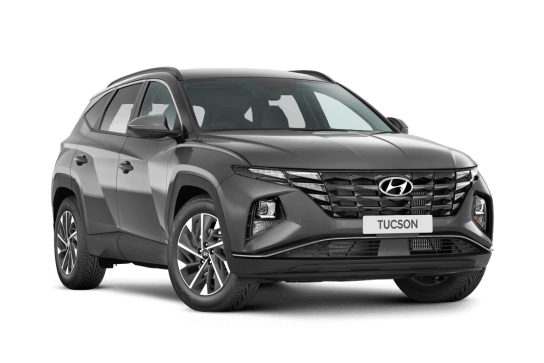
Mitsubishi Outlander Exceed and XLS 2015 review
Murray Hubbard road tests and reviews the Mitsubishi Outlander with specs, fuel consumption and verdict.
Browse over 9,000 car reviews
Changing the name of the popular SUV could be a gamble - but Hyundai holds some handy cards.
What's in a name? Hyundai is about to find out.
Its ix35 is the second-best selling SUV in the country this year, behind Mazda's CX-5. And if current buying trends continue, one of them eventually could be Australia's most popular nameplate.

So it's a brave move to change the name of the ix35 to Tucson - a name the company used for its mid-sized SUV between 2004 and 2010. But chief operating officer John Elsworth doesn't see it as a gamble.
"It's a global decision. That happens in a big entity like Hyundai," he says. "We didn't actually spend much time talking about it because there's no point. You get on with solving the issue of creating awareness of a new car like Tucson rather than wondering about what might have been."
And the company won't be doing anything different to launch the new name to the market, apart from redirecting search engines from ix35 to Tucson.
Elsworth says the new model comes at a time when SUVs are the must-have item on the road.
"It is from our point of view an incredibly positive time to be launching a new model and capitalise on Australia's love affair with SUVs," he says.
The new Tucson is bigger and better equipped than the ix35 it replaces. It's also more expensive - $1000 more on the cheapest model, more still on other grades.
It's longer and wider than the ix35, with more boot space and higher quality finishes in the cabin. It's also quieter and more refined, thanks to extra sound insulation and revised suspension.
The headline acts for the new model are safety and infotainment innovations and a turbocharged engine matched to a trick dual-clutch transmission.
Much of the safety technology, unhappily, is available only on the more expensive models.
The top-of-the-range Highlander, from $43,490, is a technological tour-de-force. It will park itself, slam on the brakes for you at low speeds, make sure you don't wander out of your lane and help when you want to change lanes, check for cars when you're reversing out of a parking spot and follow the road with its headlights.
It will even keep an unruly trailer under control and open the tailgate if it senses you at the rear.
The standard safety package is less generous, although it includes a reversing camera, parking sensors, six airbags and auto headlights. Satnav isn't standard but from September the two cheapest variants will have a new level of connectivity for the brand.
If you have an iPhone (or, from next year, an Android), the car will read your emails aloud and check your calendar. It will also link with music and navigation apps and allow you to use Siri voice activation. This new tech isn't available on the higher grades because their standard satnav unit isn't compatible. Hyundai is looking for a solution but doesn't have one yet.
Higher grade models miss out on other items too. You can get leather on the cheaper Active X but not on the Elite, next up in the range.
The new range expands to four models and four engine choices. The Active X slots between the existing Active and Elite models. Active and Active X are available only as petrol 2WDs while Elite comes in 2WD or 4WD, with two petrol options and one diesel. The Highlander is 4WD-only, with petrol or diesel.
Elite and Highlander models get the 1.6-litre turbo that powers the Veloster coupe (130kW/265Nm), linked to the new seven-speed dual-clutch transmission, while the current 2.0-litre direct injection petrol engine is available on Active X (121kW/203Nm).
Another 2.0-litre petrol will be available on Active and Elite but won't arrive until the Active is launched later this year.
The diesel engine carries over - slightly tweaked - from the previous model.
It's the first Hyundai to get an exterior design overseen by Peter Schreyer, the man credited with changing the look of sister brand Kia
The Tucson is 75mm longer than the ix35 and has a longer wheelbase and track, creating greater interior space and bringing the dimensions closer to those of the rival CX-5 — its load area is larger than the Mazda's.
It sits lower on the road than its predecessor and is the first Hyundai to get an exterior design overseen by Peter Schreyer, the man credited with changing the look of sister brand Kia. It adopts the more modern family face and is a less fussy design all around.
The Tucson is a global production that would do the UN proud. The exterior was designed in Germany, its interior was styled in California and it will be built in the Czech Republic and Korea. But most crucially, it was tested and tweaked in Australia.
Local tuning shows on the open road, where the Tucson is a huge leap forward from the ix35. It strikes an impressive compromise between comfort and cornering ability, cushioning passengers from bumps and potholes while remaining flat and composed through the bends.
The Tucson continues unfazed where the ix35 would buck if it hit a mid-corner bump. The steering feels more solid, tracking more accurately through bends, and there's more grip in corners. The brake feel could be better, though.
The cabin is also quieter and the engine noise better damped, although the base 2.0-litre engine needs a fairly healthy dose of throttle for overtaking manoeuvres. The six-speed transmission slurs its changes smoothly, though, and keeps the engine where it's most effective.
Step up to the 1.6-litre turbo and there's more response, particularly off the mark, and the engine feels more relaxed at highway speeds, loping along at lower revs. The dual-clutch transmission is effective, although occasionally hesitates when asked to kick-down in a hurry (as do most such autos).
The Tucson is also a step forward inside, where the dash design is less fussy and has a more premium feel
Impressively quiet, its deep well of torque making light work of hills, the diesel is the pick of the engines. Its fuel advantage over a petrol version has narrowed (it uses 6.4L/100km to the turbo petrol's 7.7L), making the payback for the diesel premium longer.
The Tucson is also a step forward inside, where the dash design is less fussy and has a more premium feel, thanks mainly to the bigger centre screen. The layout is logical and simple, with better quality finishes, although the hard plastic on top of the dash jars with the soft below.
Rear leg room is good for the class and the load area is more generous than most.
Overall, the new Tucson sets a new benchmark for Hyundai and should pick up where the ix35 left off. It's a gamble in name only.
| Vehicle | Specs | Price* | |
|---|---|---|---|
| Active (FWD) | 2.0L, ULP, 6 SP AUTO | $18,370 – 23,320 | 2015 Hyundai Tucson 2015 Active (FWD) Pricing and Specs |
| Active X (FWD) | 2.0L, ULP, 6 SP MAN | $18,150 – 22,990 | 2015 Hyundai Tucson 2015 Active X (FWD) Pricing and Specs |
| Elite (AWD) | 1.6L, ULP, 7 SP AUTO | $18,700 – 23,650 | 2015 Hyundai Tucson 2015 Elite (AWD) Pricing and Specs |
| Elite (FWD) | 2.0L, ULP, 6 SP AUTO | $20,350 – 25,740 | 2015 Hyundai Tucson 2015 Elite (FWD) Pricing and Specs |
$9,999
Lowest price, based on 155 car listings in the last 6 months